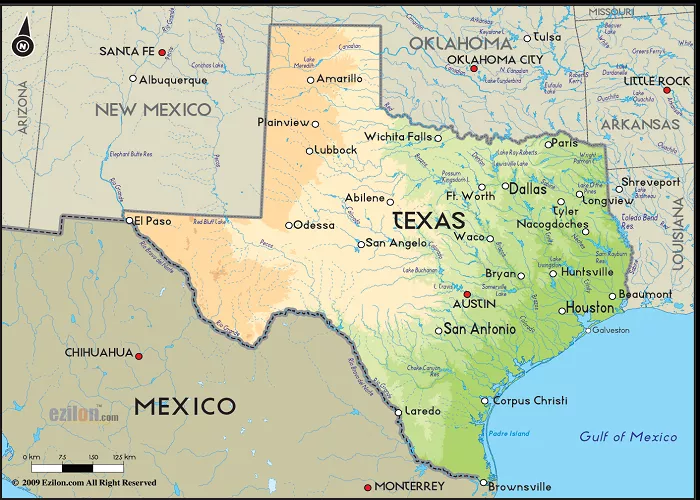When people think of Texas, they often imagine vast deserts, cowboys, and cacti. But how much of Texas is actually a desert? The answer might surprise you. While parts of Texas have arid landscapes, only a small portion qualifies as a true desert.
Geographical Overview: Is Texas a Desert State?
What Defines a Desert?
A desert is an area that receives less than 10 inches (25 cm) of rainfall per year. Deserts also have high evaporation rates, meaning water disappears quickly. The most famous deserts in the U.S. are the Sonoran Desert (Arizona/California) and the Chihuahuan Desert (West Texas/New Mexico).
Desert Regions in Texas
Only the western part of Texas falls into the desert category, specifically:
- The Trans-Pecos region (Big Bend, El Paso, and areas near the Rio Grande)
- Parts of the Edwards Plateau and High Plains
The Chihuahuan Desert, the largest desert in North America, stretches into Texas from Mexico. Key desert cities in Texas include:
- El Paso (on the edge of the Chihuahuan Desert)
- Fort Stockton
- Marfa (known for its arid climate)
Non-Desert Regions of Texas
Most of Texas is not a desert. The state has:
- Grasslands and prairies (Central and North Texas)
- Forests (East Texas Piney Woods)
- Coastal marshes (Gulf Coast)
- Hill Country (Central Texas with rolling hills and rivers)
Conclusion: Only about 10% of Texas is considered desert, mostly in the far west.
Climate and Weather in Texas Desert Regions
Hot Summers, Mild Winters
Desert areas in Texas have:
- Extreme summer heat (often over 100°F / 38°C)
- Cool winters (sometimes below freezing at night)
- Low humidity (dry air makes heat feel more bearable)
Low Rainfall and Droughts
- Annual rainfall is less than 12 inches (30 cm) in desert zones.
- Monsoon season (July-September) brings short, heavy rains.
- Droughts are common, affecting farming and water supply.
Wind and Dust Storms
- Strong winds can create dust storms (like those seen in West Texas).
- Sand dunes exist in areas like Monahans Sandhills State Park.
Cultural Significance of Texas Deserts
Native American Heritage
- Tribes like the Apache and Comanche lived in West Texas deserts.
- Rock art and ruins can still be found in Big Bend National Park.
Cowboy and Ranching Culture
- Cattle ranching thrives in arid regions due to hardy desert grasses.
- Rodeos and cowboy traditions remain strong in towns like Alpine and Fort Davis.
Modern Desert Communities
- El Paso blends Mexican and American cultures.
- Marfa is famous for art installations and the mysterious “Marfa Lights.”
Economic Impact of Desert Regions in Texas
Oil and Gas Industry
- The Permian Basin (West Texas) is one of the richest oil fields in the U.S.
- Fracking and drilling dominate the economy in cities like Midland and Odessa.
Agriculture Challenges
- Limited water makes farming difficult, but cotton, pecans, and cattle are key products.
- Drip irrigation helps conserve water in dry areas.
Tourism in the Desert
- Big Bend National Park attracts hikers and nature lovers.
- Guadalupe Mountains National Park has the highest peak in Texas.
Ecology and Wildlife in Texas Deserts
Unique Desert Plants
- Prickly pear cactus (common in West Texas)
- Yucca and agave plants (used by Native Americans for food and tools)
- Desert wildflowers bloom after rare rains.
Desert Animals
- Roadrunners (fast-running birds)
- Javelinas (wild pig-like creatures)
- Coyotes and rattlesnakes (adapted to harsh conditions)
Endangered Species
- Mexican long-nosed bat (pollinates desert plants)
- Desert bighorn sheep (reintroduced in Big Bend)
Environmental Threats to Texas Deserts
Climate Change Effects
- Rising temperatures could expand desert areas.
- Longer droughts threaten water supplies.
Overuse of Water
- Aquifer depletion (underground water sources are drying up).
- Urban growth in El Paso increases water demand.
Conservation Efforts
- National parks protect wildlife.
- Sustainable ranching practices help preserve land.
Conclusion
Only about 10% of Texas is classified as desert, primarily in the Trans-Pecos region. These areas have unique climates, cultures, and economies. While deserts are a small part of Texas, they play a big role in the state’s identity.
Understanding these regions helps us appreciate their beauty and challenges. Whether you’re exploring Big Bend, studying desert wildlife, or learning about West Texas oil, the desert plays a key role in Texas’ past and future.

